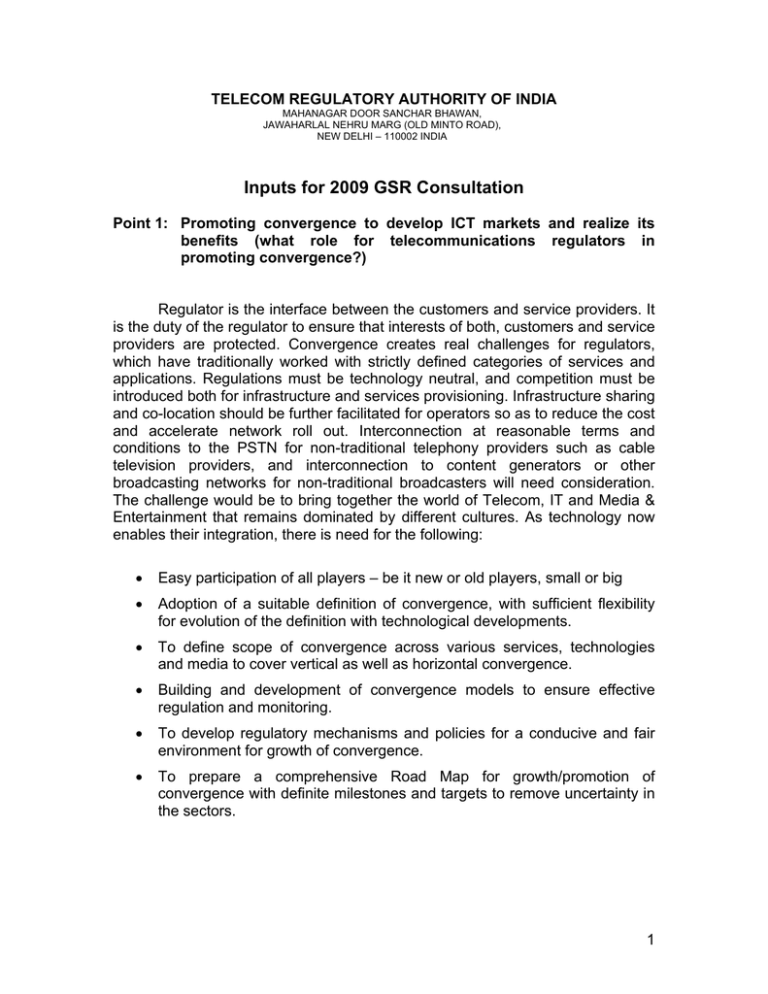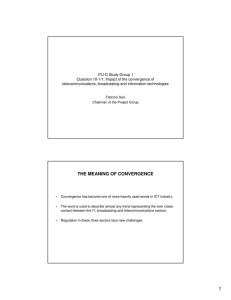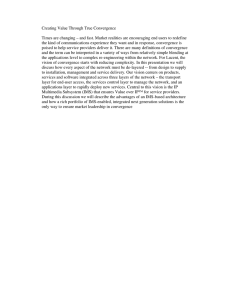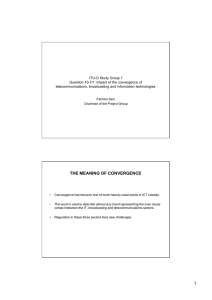Inputs for 2009 GSR Consultation
advertisement

TELECOM REGULATORY AUTHORITY OF INDIA MAHANAGAR DOOR SANCHAR BHAWAN, JAWAHARLAL NEHRU MARG (OLD MINTO ROAD), NEW DELHI – 110002 INDIA Inputs for 2009 GSR Consultation Point 1: Promoting convergence to develop ICT markets and realize its benefits (what role for telecommunications regulators in promoting convergence?) Regulator is the interface between the customers and service providers. It is the duty of the regulator to ensure that interests of both, customers and service providers are protected. Convergence creates real challenges for regulators, which have traditionally worked with strictly defined categories of services and applications. Regulations must be technology neutral, and competition must be introduced both for infrastructure and services provisioning. Infrastructure sharing and co-location should be further facilitated for operators so as to reduce the cost and accelerate network roll out. Interconnection at reasonable terms and conditions to the PSTN for non-traditional telephony providers such as cable television providers, and interconnection to content generators or other broadcasting networks for non-traditional broadcasters will need consideration. The challenge would be to bring together the world of Telecom, IT and Media & Entertainment that remains dominated by different cultures. As technology now enables their integration, there is need for the following: Easy participation of all players – be it new or old players, small or big Adoption of a suitable definition of convergence, with sufficient flexibility for evolution of the definition with technological developments. To define scope of convergence across various services, technologies and media to cover vertical as well as horizontal convergence. Building and development of convergence models to ensure effective regulation and monitoring. To develop regulatory mechanisms and policies for a conducive and fair environment for growth of convergence. To prepare a comprehensive Road Map for growth/promotion of convergence with definite milestones and targets to remove uncertainty in the sectors. 1 Point 2: Building effective regulatory institutions (converged regulator or cooperation amongst sector specific regulators?) The advent of digital media has made it possible for voice, data, video, and audio, all to be carried by any technology. Owing to technological developments the same network platform is being used to offer various services that traditionally required separate licenses. Similarly different network platforms are being used to offer similar services. The use of common networks for transport of telecom, broadcasting and other data makes the Regulation of content very important Security of the network critical as the circuits are shared QoS assurance becoming important especially for real-time applications. It would therefore be ideal if a converged regulator encompassing telecom, broadcasting and IT is in place to handle the regulatory challenges in such a scenario. The converged regulator may be able to regulate and promote convergence more effectively by taking into account opportunities, constraints and other factors of ICT stakeholders in a uniform and combined manner. Also in case of different sector regulators, it is imperative that any policy having a bearing on convergence is framed after due consultation with all the regulators. In a converged scenario, Content Regulators would have a major role especially with respect to regulating its pricing, sharing, tariffs for converged services etc. Point 3: Using regulatory tools to stimulate investment in a converged world There is a need for an economic and political framework to encourage massive investment in infrastructure. There is necessity that the policy makers and regulators stimulate investment in infrastructure to handle the demand for converged data services. Infrastructure sharing and co-location should be further facilitated for operators so as to reduce the cost and accelerate network roll out. Regulatory policies should be formulated to promote competition in the field of convergence by creating low entry barriers, allowing sharing of infrastructure across various ICT segments and by stipulating minimal revenue sharing. To stimulate investment, the regulatory policies and principles should strive to ensure uniformity in licensing terms and conditions across the ICT sectors. In particular, uniform license terms and conditions relating to revenue and license fee are desirable for different ICT segments. 2 Point 4: Stimulating growth in innovative applications and devices towards connecting the unconnected The challenge of connecting the unconnected remains tough. While mobile coverage has improved significantly across all regions, high speed broadband connectivity required for key business and government applications and services in many developing and least developed countries is either not available or prohibitively expensive. Traditional business models, especially in rural and remote areas often do not support the needed investment. In addition, insufficient local content is available that too few people have training in the required technologies. To overcome these challenges, new approaches like development of content in vernacular, infrastructure sharing and innovative public-private partnerships, involving stakeholders working together towards a common goal are essential. 3





